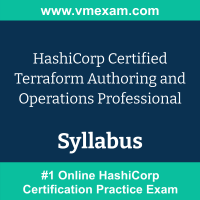 The HashiCorp Terraform Authoring and Operations exam preparation guide is designed to provide candidates with necessary information about the Terraform Authoring and Operations exam. It includes exam summary, sample questions, practice test, objectives and ways to interpret the exam objectives to enable candidates to assess the types of questions-answers that may be asked during the HashiCorp Certified - Terraform Authoring and Operations Professional exam.
The HashiCorp Terraform Authoring and Operations exam preparation guide is designed to provide candidates with necessary information about the Terraform Authoring and Operations exam. It includes exam summary, sample questions, practice test, objectives and ways to interpret the exam objectives to enable candidates to assess the types of questions-answers that may be asked during the HashiCorp Certified - Terraform Authoring and Operations Professional exam.
It is recommended for all the candidates to refer the Terraform Authoring and Operations objectives and sample questions provided in this preparation guide. The HashiCorp Terraform Authoring and Operations certification is mainly targeted to the candidates who want to build their career in Infrastructure Automation domain and demonstrate their expertise. We suggest you to use practice exam listed in this cert guide to get used to with exam environment and identify the knowledge areas where you need more work prior to taking the actual HashiCorp Certified Terraform Authoring and Operations Professional exam.
HashiCorp Terraform Authoring and Operations Exam Summary:
|
Exam Name
|
HashiCorp Certified Terraform Authoring and Operations Professional |
| Exam Code | Terraform Authoring and Operations |
| Exam Price | $295 USD |
| Duration | 240 minutes |
| Number of Questions | 57 |
| Passing Score | Pass / Fail (Approx 70%) |
| Recommended Training / Books | Prepare for the exam |
| Schedule Exam | Cloud Engineer Certification Exam Portal |
| Sample Questions | HashiCorp Terraform Authoring and Operations Sample Questions |
| Recommended Practice | HashiCorp Certified - Terraform Authoring and Operations Professional Practice Test |
HashiCorp Terraform Authoring and Operations Syllabus:
| Section | Objectives |
|---|---|
| Manage resource lifecycle |
- Initialize a configuration using terraform init and its options - Generate an execution plan using terraform plan and its options - Apply configuration changes using terraform apply and its options - Destroy resources using terraform destroy and its options - Manage resource state, including importing resources and reconciling resource drift |
| Develop and troubleshoot dynamic configuration |
- Use language features to validate configuration - Query providers using data sources - Compute and interpolate data using HCL functions - Use meta-arguments in configuration - Configure input variables and outputs, including complex types - Analyze best practices for managing sensitive data, such as using Vault for secrets management |
| Develop collaborative Terraform workflows |
- Manage the Terraform binary, providers, and modules using version constraints - Configure remote state - Use the Terraform workflow in automation - Share data across configurations and workspaces |
| Create, maintain, and use Terraform modules |
- Create a module - Use a module in configuration - Refactor a module and use module versioning - Refactor an existing configuration into modules |
| Configure and use Terraform providers |
- Understand Terraform's plugin-based architecture - Configure providers, including aliasing, versioning, sourcing, and managing upgrades - Manage provider authentication - Troubleshoot provider errors |
| Collaborate on infrastructure as code using HCP Terraform |
- Analyze the HCP Terraform run workflow - Understand HCP Terraform workspaces and their configuration options, including access management - Manage provider credentials in HCP Terraform - Analyze policy as code and governance features |
